Imagine a solar powered sail that could propel a space craft through the vacuum of space like a wind that drives a sail here on Earth. The energy of photons steaming from the Sun alone would provide the thrust. NASA and other space agencies are taking the idea seriously and are working on various prototype technologies. Edward Montgomory is the Technology Area Manager of Solar Sail Propulsion at NASA. They just tested a 20-meter (66 foot) sail at the Glenn research center’s Plum Brook facility in Sandusky, Ohio.
Continue reading “Podcast: NASA Tests a Solar Sail”
Audio: NASA Tests a Solar Sail
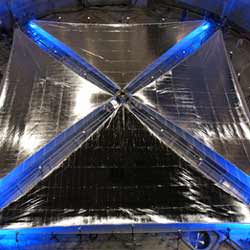
A 20-metre solar sail being tested. Image credit: NASA. Click to enlarge.
Listen to the interview: NASA Tests a Solar Sail (3.7 mb)
Or subscribe to the Podcast: universetoday.com/audio.xml
Fraser Cain – Can you give me some background on solar sails in general?
Edward Montgomery ? This is a technology that our agency has been interested in for some time, but the history goes back several hundred years to Fredrick Sander at the turn of the century (19th). In more recent times, we have found that advances in a couple of particular areas have made it something that we really have to look into. The composite materials that have been coming out in the last couple of years, such as in sports equipment that is made out of ultra, lightweight rods, and film technology which in some ways is related to the materials industry and integrated circuits fields for instance and paint additives. These fields have made it possible to build structures in space that are gossamer-like and we have never really been able to do that till a couple of decades before (now) and once you can get the kind of mass down really low, then it doesn’t take a lot for force to get some acceleration and some good propulsion out of it.
How can light provide propulsion to aluminum foil in space?
That’s a very fascinating property that light has; it doesn’t really have mass, so it can’t bounce off of something, but in fact it does interact with obstructions; it does impart momentum to it and this was theorized by Einstein and it has been proven in a number of laboratory experiments.
What is the technology that you are testing at NASA right now?
We are taking one particular solar sail concept which is a square sail; it has 4 booms that come out and in between the booms are triangular sails and that system is designed to carry payloads that are relatively modest in size: the Robotic Science payload. We’re looking at several missions to the inner solar system to study the physics of the Sun and how it interacts with the Earth.
So you would be sending your solar sail in from our position; the Earth’s orbit, closer into the Sun? Sounds kind of backwards to me.
Well, the thrust that the sail can produce is proportional to the strength of the sunlight and as you go closer to the Sun, the strength of that propulsion goes up as the square of the distance as you get closer so actually, it works much more efficiently close to the Sun. The missions that have been planned to look at the outer solar system; almost all of them have involved first going to the inner solar system flying close to the Sun and getting a good boost and then going out. But the near term missions that we are looking at are missions that hover; they don’t go really fast. There is a balance point between the Earth’s gravitational pull and the Sun’s gravitational pull called the Lagrange point, and we have satellites that site there now. That doesn’t require any particular propulsion, but if you want to sit and hover at some point closer to the Sun (to get to) that particular point in space, then you have to have some propulsion capabilities and our scientists have an intense interest at wanting to be at that point. You can imagine how that might be an advantageous place to put some instruments in between the Earth and the Sun to understand how that physical property is.
Ok, so I understand; it would be as if the Sun was a fan and you had your sail and you let it drift down towards the Sun to the point that the force of the Sun’s energy coming off of it is perfectly balanced to hold the solar sail at the point. It wouldn’t go any further or go any closer.
Right. That is correct.
What kind of experiments would you be interested in doing if you could get that close and be able to station keep?
I’m a propulsion engineer, not a research scientist; they can do a much better job of explaining what exactly they’re studying, but some of the instruments that they plan to put on it measure the magnetosphere, they measure high energy particles as they go by. Of particular interest is sensing coronal mass ejections; these are the large flare events that happen on the Sun, that once they reach Earth can really disrupt our communications and they actually can harm and destroy sensitive electronic equipment. Such a flare in 1986 caused several million dollars of damage in North America alone so we want to be able to predict those events when they are happening and if we have enough warning time, we can turn our equipment off or in particular conditions, keep them from getting hurt so it is important to know when a coronal mass ejection is coming.
What could the future hold for this technology, with being able to explore the outer solar system?
Well, that’s a good point. As I just mentioned, these coronal mass ejections also can be very harmful to our astronauts so NASA is looking in the near future to going back to the Moon and Mars which there has been a lot of discussion of. We’ll need to be able to predict when these events (coronal mass ejections) happen so that our astronauts can get to safe havens from those events, so we will probably need to have these warning satellites positioned near the moon and mars and possibly around the solar system for a warning in doing that. (After that) eventually in the future there is an intense interest in wanting to understand the structure of our solar system outside the orbit of Pluto, particularly the Heliopause, now the Voyager space craft has just entered that region; there’s been some interesting results coming back in there; and there is a lot that we’d like to know about in that region of space. Just beyond that is something called the Oort Cloud which is supposedly the area of space where a lot of the comets that we see live most of their lives, but occasionally they come into the Sun. So there’s quite a bit of science to be done; observing and exploration just beyond the edges of the solar system.
Would anything be different in building a solar sail to that could travel out into the outer solar system then what you are working on right now?
It doesn’t have to be. You could take the technology that we are pursuing now to do these coronal mass ejection signals and you could send that sail on a mission. The problem is that it would take or more to get to those Oort Clouds and out into the Heliopause. If we can build a sail that is a order of magnitude or a tenth of the weight for the same amount of area; that is performs 10 times better if you will, then we can make that same mission in half the time, so to really start considering that mission, we will want to build higher performing sails to really do it and to do it within our lifetime, if you will.
What is the time frame now on forward with the prototype you are testing and your future plans?
That’s something that there is a lot of studying going on in the agency right now; particularly, there is a science advisory committee that’s meeting and determining what their science priorities are and that will set the need date for when sails need to be ready. When it can be ready?, well what we’ve been doing over the last 3 years that has culminated in these tests at Plumbrook is to do the best we can on the ground to design and operate a solar sail in a simulated space environment. The next step is to go up into space and that’s going to be an important step. We really have to have a flight of the solar sail and see how it operates in space: the loads on the structure of the sail are much, much less than they are here on the ground. Gravity puts a load on the sails 4000 times higher than what the Sun will do. So a really true environment is in space and we have to take it (the sail) up to test it out. That’s another 3-5 years to do that sort of thing, and then it will be ready to be infused into a science mission; 3-5 years nominal space mission planning and development phase. So, within the next decade, certainly, I expect to see a solar sail flying.
Did Iapetus Consume One of Saturn’s Rings?
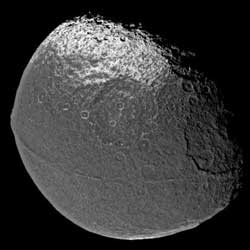
Saturn’s moon Iapetus and its strange “rindge”. Image credit: NASA/JPL/SSI. Click to enlarge.
Is there any more mysterious and beautiful planet for the observer than Saturn? While all four gas giants in our solar system have a ring system, only Saturn’s can be seen from Earth. Backyard astronomers have long been thrilled to witness its two bright rings and the dark Cassini division, while observatory telescopes have identified many separate rings and gaps. Not until the beginning of the 1980’s when Voyager made it’s “fly-by” were we aware of more than a thousand individual rings bound by the gravity of Saturn and its many small moons. The rings themselves are nothing more than icy particles ranging in size from dust motes to boulders. Joining in this intricate dance are the satellites – from Mercury-sized atmospheric Titan to tumbling, eccentrically orbiting Hyperion. Since the late 18th century we have known of Titan, Mimas, Enceladus, Tethys, Dione, Rhea and Iapetus. Our studies have revealed that four of the moons play a key role in shaping Saturn’s ring system – Pan, Atas, Pandora and Prometheus. We know that Enceladus’ highly reflective surface is comprised of ice and that Iapetus is much brighter one one side than the other…
And may have collected a ring as it swept through orbital changes.
From the time of its discovery in 1672, we have been aware the leading hemisphere of Iapetus is fully a magnitude darker than the trailing side. Thanks to the Cassini mission’s images taken in December 2004, the presence of a large equatorial ridge has been discovered on Iapetus’ dark side.
According to a Geophysical Research Letter submitted on the 29th of April by Paulo C.C. Freire of Arecibo Observatory, “…this ridge and the dark coating of the hemisphere on which it lies are intimately interlinked and are the result of a collision with the edge of a primordial Saturnian ring, ultimately caused by a sudden change in the orbit of Iapetus”. Says Freire, “Because of its unique nature, we will henceforth refer to the equatorial ridge of Iapetus simply as ‘the Rindge’ to mean that this feature is not a ridge in the usual sense of the term; i.e., a mountain chain caused by tectonic process. This model naturally explains all of the unique features of this satellite; and is probably the solution to one of the oldest mysteries in solar system astronomy.”
One of the scientific goals of the Cassini fly-by imaging was to shed some light on Iapetus’ dark side, called Cassini Regio. To the surprise of the researchers, it revealed a great equatorial ridge unlike anything else found in the solar system – a ridge so symmetrical relative to the Cassini Regio that the two features must be linked, as acknowledged previously by Carolyn Porco – head of the Cassini Imaging Team. The majority of the clues point to how the ring system and the forming moons once orbited Saturn itself.
Current understanding of the formation of the solar system (and, in a smaller scale, the Saturnian system) indicates that many planetoids (and proto-satellites) may have once started in orbits that later became unstable. They could have collided with each other, or been ejected from their system by close encounters with others. In the case of Saturn, it is possible they could have been tidally disrupted when approaching Saturn’s gravity and formed ring systems. Closer to the planet, in an area known as the “Roche Zone”, the tidal pull of Saturn prevents proto-satellite formation from ring particles. In order for the ring collision theory to match what Cassini has imaged, Iapetus had to have been one of these moons with unstable orbits.
Evidence points to the fact that something changed Iapetus’ orbit before colliding with ring material. Had this not happened, the ring would have adjusted to Iapetus’ gravity as evidenced by satellites currently imbedded within the rings. In the case of these satellites – no collision scenario can occur. In Iapetus’ circumstance, its orbit was necessarily eccentric, or no velocity differences would exist between Iapetus and the ring particles and again – no collisions would occur.
An impact with a ring also suggests this changed orbit had a perisaturnium at the outer edge of the Roche Zone, where rings can exist for longer periods of time. This is a clue that Iapetus was quite probably much closer to Saturn than its present orbit. “The existence of the rindge suggests the orbit of Iapetus at the time of the collision was equatorial” says Freire, “otherwise, with its present inclination a collision with a ring would not produce a sharp edge, but something more like a wispy dark coating of the leading hemisphere.” In conclusion, a satellite with an equatorial and eccentric orbit has a very large probability of interacting further with other satellites – providing the means to change yet again to a different orbit.
Now that we have set the stage, how do the images taken of this unique rindge support the theory? According to Freire, “The ring collisions scenario naturally produces a linear feature exactly at the equator: this is the geometric intersection of a ring plane and the surface of a moon with a (previously) equatorial orbit.” Very careful consideration has been given to tectonics, but such a perfectly linear formation – located exactly at the equator – is unlikely to result from tectonic processes and Iapetus shows no signs of volcanic activity.
“Another key feature of the rindge is that its height varies extremely slowly with longitude,” says Freire, “This can be expected from deposition of material from a ring, but such a constant height has never been observed for any tectonic feature. If the origin of the rindge was tectonic and preceded the dark coating, then it should not necessarily be confined to Cassini Regio. If it postdated the coating, then the rindge being built from an upwelling from the interior of Iapetus should be much brighter than the surrounding surface.”
Considerable analysis has been given to the information that Cassini imaging has provided. The longitudinal length of the ridge is less than 180 degrees, which suggests that Iapetus was never fully inside the ring region – indicating that it just collided with a ring edge. Celestial mechanics considerations indicate that a collision with a ring edge should have caused an eastward motion of the particle’s impacts relative to the surface of the satellite. “This accounts for an important observed fact: although Cassini Regio is symmetrical relative to the rindge in the north/south direction, it is not so in the east/west direction.” This collision model suggests that the rindge would be taller on the western side where the impacts were closer to vertical and then would slowly digress moving eastward – a fact supported by the images. With millions of impact craters being formed every second along a line, this pattern would become unmistakable. The sublimation of the ices contained in the impacting particles would produce a transient atmosphere, with a strong pressure gradient away from the rindge. This gradient would produce fast winds capable of carrying fine dust. Says Freire, “In our hypothesis, the dust deposited by such winds is the dark coating of the region known today as Cassini Regio.” Such a scenario is supported by other evidence: “The dark streaks observed at the edge of Cassini Regio indicate that it was a wind blowing from the equator that deposited the ‘dust’. We can be certain of this because Cassini imagery shows clearly that the dust is deposited downward from the crater rims.” This can’t be accounted for by ballistic flight of the particles from the equator, as suggested by the leader of the Cassini Imaging Team, Carolyn Porco. It can’t be produced in present-day Iapetus, since it has no atmosphere. The conclusion that a transient atmosphere once existed becomes inescapable.
Could these exciting findings truly be from an earlier impact with one of Saturn’s rings? The clues certainly seem to make the pieces of the puzzle fit together neatly. Thanks to work done by researchers like Paulo Freire, we may have solved a 333 year-old solar system mystery.
Written by Tammy Plotner, with many thanks to Paulo Freire for his contributions.
Dione and Tethys
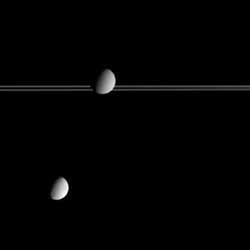
Saturn’s moons Dione and Tethys poised above Saturn’s rings. Image credit: NASA/JPL/SSI. Click to enlarge.
Saturn’s moon Dione occults part of Saturn’s distant rings while Tethys hovers below. Dione is 1,118 kilometers (695 miles) across, while Tethys is 1,071 kilometers, 665 miles) across.
This image offers excellent contrast with a previously released view (see Sister Moons) that showed the bright, wispy markings on Dione’s trailing hemisphere. The huge impact structure Odysseus (450 kilometers, or 280 miles across) is near the limb of Tethys. Compared with the battered surface of Tethys, Dione appears much smoother from this distance.
The image was taken in visible light with the Cassini spacecraft narrow-angle camera on March 19, 2005, at a distance of approximately 2.7 million kilometers (1.7 million miles) from Saturn. The image scale is approximately 15 kilometers (9 miles) per pixel.
The Cassini-Huygens mission is a cooperative project of NASA, the European Space Agency and the Italian Space Agency. The Jet Propulsion Laboratory, a division of the California Institute of Technology in Pasadena, manages the mission for NASA’s Science Mission Directorate, Washington, D.C. The Cassini orbiter and its two onboard cameras were designed, developed and assembled at JPL. The imaging team is based at the Space Science Institute, Boulder, Colo.
For more information about the Cassini-Huygens mission visit http://saturn.jpl.nasa.gov . For additional images visit the Cassini imaging team homepage http://ciclops.org .
Original Source: NASA/JPL/SSI News Release
First MARSIS Boom Fixed
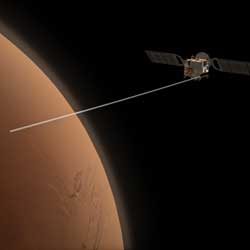
Artist illustration of Mars Express with one MARSIS boom deployed. Image credit: ESA. Click to enlarge.
Thanks to a manoeuvre performed on 10 May 2005 at 20:20 CET, ESA flight controllers have successfully completed the deployment of the first boom of the MARSIS radar on board ESA’s Mars Express spacecraft.
After the start of the deployment of the first 20-metre boom on 4 May, analysis by flight controllers at ESA?s European Space Operations Centre, Darmstadt, Germany, had shown that although 12 out of the 13 boom segments were in place, one of the outermost segments, possibly No. 10, had deployed but was not locked into position.
Deployment of the second (20 m) and third (7 m) booms was suspended pending a full analysis and assessment of the situation.
As prolonged storage in the cold conditions of outer space could affect the fibreglass and Kevlar material of the boom, the mission team decided to ?slew? (or swing) the 680 kg spacecraft so that the Sun would heat the cold side of the boom. It was hoped that as the cold side expanded in the heat, it would force the unlocked segment into place.
After an hour, Mars Express was pointed back to Earth, and contact re-established at 04:50 CET on 11 May. A detailed analysis of the data received showed that all segments had successfully locked and Boom 1 was fully deployed.
The operations to deploy the remaining two booms could be resumed in a few weeks, after a thorough analysis and investigation of the Boom 1 deployment characteristics.
The Mars Express Sub-Surface Sounding Radar Altimeter (MARSIS) experiment is to map the Martian sub-surface structure to a depth of a few kilometres. The instrument’s 40-metre long antenna booms will send low frequency radio waves towards the planet, which will be reflected from any surface they encounter.
MARSIS is one of the seven science experiments carried on board Mars Express, one of the most successful missions ever flown to the Red Planet. Mars Express was launched on 2 June 2003 and entered Mars orbit in December 2003.
Original Source: ESA News Release
DVD Review: Enterprise Season 1 DVD

Within this seven DVD collection are the 25 shows of the first season, starting with the pilot entitled ‘Broken Bow’ and ending with the season cliff hanger ‘Shockwave Part 1’. Following the final show, special features add insight to the cast and sets. Scott Bakula, the captain and apparent driving force of the show, provides a personal monologue on his views of the casting and thoughts of the early days. A perennial Star Trek guest actor, Vaughn Armstrong (here Admiral Forrest), also waxes a little bit on his times with the genre. Surprisingly, there is little time given for other actors to present their off-stage personalities and perceptions. The Shuttle Pod construction and engine room layout get a greater presence. However, a set of out takes, the now classic addition to any DVD, shows the lighter and more natural side of most of the main characters as they closely worked together in this first season.
Aside from this additional footage, there are optional overlays. Text commentaries by Michael Acadia (Scenic Art Supervisor/Technical Consultant) and Denise Acadia. (Video Supervisor) provide relevant on-screen notes for three episodes. The information regards actors, sets and props, as well as of the Star Trek storyline. The actor notes include previous roles (in and outside Star Trek). Sets and props show the continual transmogrification of equipment for this 18 year old series, particularly as stages and sets moved from Voyager’s realm to Enterprise’s. And, perhaps best of all, the storyline notes link a character or event to other shows of this season or elsewhere in the franchise. Whether interested in some minutia about the set’s background or discussing trivia about the flow of Star Trek history, these overlays make for a pleasant diversion.
Much more rewarding is the audio commentary by the show writers/producers Brannon Braga and Rick Berman which (optionally) plays overtop the dialogue of the season opener. This running commentary, for the duration of the show, explains the rational for the show’s premise, the choice of actors, the process for writing shows and best of all, the scene definition and selection (e.g. the use of computer generation and/or actors). Amongst many other tidbits, Braga and Berman describe how their main objective for this series was character development. Also, continual reference to interweaving today’s functioning technology with perceived novelties from the original series highlights some of their challenges. For example, today’s digital cell phones/cameras provide more functionality in a smaller package than Kirk’s communicators. However, because of the dialogue overlay, the show is unwatchable so, first, watch the season pilot without the audio commentary and then re-watch it with the audio commentary.
Deleted scenes follow eight of the shows. Presumably these (and likely much other footage) were cut as being inappropriate. Yet, by including them as separate segments they are still inappropriate, if not more so. If these were instead part of an optional extended version then they and the DVD collection itself would have had original and noteworthy elements to add interest for regular and new viewers.
The Star Trek Enterprise series went boldly onto a path that many series had gone before. Writers and actors knew that they had to provide something new and entertaining to continue the Star Trek genre. As a prequel, this series does offer a new, refreshing view point. Emphasizing character (and racial) development over exploration and discovery expands on this novelty. On top of the story itself, this DVD collection of Enterprise’s Season 1 contains background information about the plot, filming and actors that helps the initiated and neophyte learn about the path being taken and the difficulties in staying aligned.
A little faith of the heart and you can be dancing amongst the stars. Waiting for that warp drive engine though might be long and depressing so keep your spirits up by enjoying the works of some of Hollywood’s stars. Star Trek Enterprise Season 1 is the 7 DVD set with the 25 shows of the latest and perhaps final installment of the Star Trek, another in the warm tradition of guessing how we might visit other sols and who we might be dancing with when we arrive.
Read more reviews or purchase the DVD set online from Amazon.com.
Review by Mark Mortimer.
Smallest Ever Coronal Mass Ejection
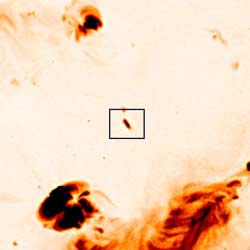
A negative image of the Sun showing the active region. Image credit: PPARC. Click to enlarge.
Solar physicists have observed the smallest ever coronal mass ejection (CME) – a type of explosion where plasma from the Sun is thrown out into space, sometimes striking the Earth and damaging orbiting satellites. The observation has come as a great surprise to scientists and has turned previous ideas up-side-down.
To date studies of these phenomena have focussed on large explosions which are easier to detect and which have massive footprints on the Sun, sometimes covering thousands of millions of square miles. But in a paper published in the May edition of Astronomy and Astrophysics, an international team from the UK, Argentina, Finland, France and Hungary showed that CMEs can also be produced from regions as small as the Earth, around 10,000 miles across. This still may sound large but it is tiny by cosmic standards.
CMEs are believed to be caused by the destabilisation of twisted loops in the Sun’s magnetic field, which contain lots of energy, settling into more stable positions (like a twisted rubber band unwinding suddenly). Until now, the events have been traced back to large areas of magnetic activity on the Sun, but the new observations relate to an area much smaller than anything seen before. However, even though the event was small it was still energetic enough to reach the Earth and amazingly the magnetic field lines were ten times more twisted than is usually seen in the larger areas.
Understanding CMEs and the mechanisms that power them is important because the plasma and accelerated particles they throw into space can damage satellites, cause harm to astronauts and even affect the Earth itself, causing beautiful aurora but also power black outs and problems to radio signals. This is the science of space weather.
Dr Lucie Green of UCL’s Mullard Space Science Laboratory said “Previously coronal mass ejections were thought to be huge, involving massive portions of the Sun’s magnetic field and all the theoretical models are based around this assumption. However, this one was amazing in that it came from a tiny magnetic region on the Sun which would normally have been overlooked in the search for CME source regions. This will be an exciting area for further study.”
Existing models for CMEs are based on the type of large event previously observed and the team cannot yet say how frequent such mini CMEs are or whether they represent a significant part of space weather. The event was so small that is was almost at the limit of what we can see with current instruments. Future missions studying the Sun will be able to ‘see’ in much better detail, such as the UK-US-Japanese mission called Solar-B.
The research used data from NASA/ESA’s SOHO spacecraft, NASA’s TRACE satellite and from the now defunct Japanese/US/UK Yohkoh satellite. UK involvement was funded by PPARC.
Original Source: PPARC News Release
The Birth of a New Black Hole?
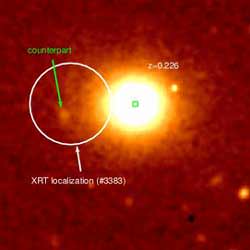
GRB 050509B, detected on 9 May 2005, was a *very* short burst, lasting just 30 milliseconds. Image credit: NASA/JPL. Click to enlarge.
After 30 years, they finally caught one. Scientists on Monday have for the first time detected and pinned down the location of a so-called “short” gamma-ray burst, lasting only 50 milliseconds.
The burst marks the birth of a black hole. The astronomy community is buzzing with speculation on what could have caused the burst, perhaps a collision of two older black holes or two neutron stars. A multitude of follow-up observations are planned; the answer might come in a few more days. “Everything about this gamma-ray burst so far supports the merger theory,” said Steinn Sigurdsson, associate professor of astronomy and astrophysics at Penn State and a gamma-ray-burst theorist.
Gamma-ray bursts are the most powerful explosions known in the universe. Recently, the longer ones — lasting more than two seconds — have become easy prey for NASA satellites such as Swift, built to detect and quickly locate the flashes. Short bursts had remained elusive until Monday, when Swift detected one, autonomously locked onto a location, and focused its onboard telescopes in less than a minute to capture the burst afterglow.
“Seeing the afterglow from a ‘short’ gamma-ray burst was a major goal for Swift, and we hit it just a few months after launch,” said Neil Gehrels, Swift project scientist at NASA Goddard Space Flight Center in Greenbelt, Maryland. “Now, for the first time, we have real data to figure out what these things are.”
Like clues left at a crime scene, the afterglow contains information about what caused the burst. Most scientists are convinced short and long bursts arise from two different catastrophic origins. The longer bursts appear to be from massive star explosions in very distant galaxies. The shorter ones — less than two seconds and often just a few milliseconds — are the deeper mystery because they have been simply too fast to observe in detail.
The Monday burst is called GRB 050509B. Swift’s X-ray Telescope detected a weak afterglow that faded away after about five minutes. Swift’s Ultraviolet/Optical Telescope did not see an afterglow. Ground-based telescopes have not yet definitely detected an afterglow either. In contrast, afterglows from long bursts linger from days to weeks.
All of this fits the pattern of a collision between some combination of black holes or neutron stars, both of which are created in the death of massive stars. Neutron stars are dense spheres about 20 miles across. Black holes have no surface and are regions in space of infinite density. Theory predicts that these kinds of collisions wouldn’t produce a long afterglow because there isn’t much “fuel” — such as dust and gas — from the objects and in the region to sustain an afterglow.
GRB 050509B appears to have occurred near an unusual galaxy that has old stars and is relatively nearby–about 2.7 billion light years away–which also is consistent with the theory that short bursts come from older, evolved neutron stars and black holes. In contrast, longer gamma-ray bursts tend to be in young, distant galaxies filled with young, massive stars — remnants of the early universe.
“We are combing the region around the burst with the Keck Telescope for clues about this burst or its host galaxy,” said Shri Kulkarni, a gamma-ray burst expert at Caltech. “What we are seeing so far is what proponents of the merger theory have been saying all along.” Such an evanescent afterglow has been expected in the most popular model for short hard bursts to date. Additional observations are planned for NASA’s Hubble Space Telescope and Chandra X-ray Observatory.
Swift is a NASA mission in partnership with the Italian Space Agency and the Particle Physics and Astronomy Research Council, United Kingdom; and is managed by NASA Goddard. Penn State controls science and flight operations from the Mission Operations Center in University Park, Pennsylvania. The spacecraft was built in collaboration with national laboratories, universities, and international partners, including Penn State University; Los Alamos National Laboratory in New Mexico; Sonoma State University in Rohnert Park, California; Mullard Space Science Laboratory in Dorking, Surrey, England; the University of Leicester in England; Brera Observatory in Milan, Italy; and ASI Science Data Center in Frascati, Italy. For more information about this and other Swift-detected bursts, refer to http://grb.sonoma.edu.
Original Source: Eberly College News Release
Mapping Life on Earth Could Predict Finding it on Mars
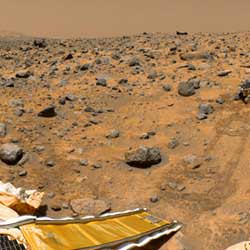
Pathfinder’s image of Mars. Image credit: NASA/JPL. Click to enlarge.
A geologist from Washington University in St. Louis is developing new techniques to render a more coherent story of how primitive life arose and diverged on Earth ? with implications for Mars.
Carrine Blank, Ph.D., Washington University assistant professor of earth and planetary sciences in Arts & Sciences, has some insight concerning terrestrial microbes that could lead to provocative conclusions about the nature of life on Mars and other planets.
Carinne Blank (below) has a method she uses to date ancient life forms that could be helpful for specimens from Mars.
Carinne Blank (below) has a method she uses to date ancient life forms that could be helpful for specimens from Mars.
Blank approaches the task by resolving phylogenetic trees. These trees, based upon genetic sequencing data, trace the genetic relationships between what we think of as primitive organisms through trait development. The relationships between early forms of life can illuminate the relationships between organisms present on Earth today ? which fossil evidence and a method called isotopic fractionation have failed to show conclusively.
Blank most recently presented her research at the 2004 annual meeting of the Geological Society of America.
Haves and have-nots
Microorganisms can be divided into haves and have-nots: cells of eukaryotes contain a nucleus, while prokaryotic organisms cells do not. Prokaryotic organisms encompass archeal and bacterial domains of life. Archeal organisms diverge further into euryarcheota and Crenarcheota lineages. By piecing together genetic sequences of the three types of prokaryotic organisms, Blank creates a genetic flow chart, which can be interpreted to trace the appearance of environmental adaptations across billions of years of evolution.
Genes are inherited from parents, but can transfer from one organism to another without reproducing by a process called lateral gene transfer. Modular metabolic genes, which are not critical for cell production, account for most lateral gene transfers between microbes.
“There is a lot we’re beginning to understand in terms of bacterial evolution that is still not quite clear,” Blank said. “What we’re trying to resolve is the evolutionary history of the core of the bacterial cell. The core is that which is not undergoing this lateral gene transfer, or does it extremely rarely.”
Jumping genes
Jumping genes may be a headache for researchers, but they serve an important ecological purpose, helping other organisms to succeed in their habitats, and can illuminate trait development across the tree of life.
“We try to construct the core with gene sequences, and then we look at the distribution of traits such as those involved in metabolism by laying it onto the tree,” she said.
Timely appearances of certain traits among prokaryotes on the tree of life can betray a trend of habitat divergence, facilitated by lateral gene transfer. The emergence of traits corresponding to measurable changes in the known geologic record allow researchers to date organisms with relative certainty. Blank can then use chronological data to analyze niche specialization, “where these organisms like to grow,” among members of each life domain over geologic time.
Habitat divergence among bacteria is consistent with patterns of divergence among the other prokaryotes, Blank’s research shows. She notes a pervasive trend of cyanobacterial organisms diverging from low-salinity environments into marine environments over time.
“We have the ancestral Archeae ? it diverges into two major lineages, the Crenarchaeota and the Euryarchaeota, one which grows in marine environments, the other on continents,” Blank said. “They grow and diverge for perhaps a billion years, and then they start colonizing each other’s environments. The marine Euryarchaeota eventually colonize the terrestrial environments and the Crenarchaeota colonize the marine environments. My point is that it could have taken a very long time for them to come back and to form even more complex ecosystems. So the literal interpretation of these patterns is that early habitat specialization could have lasted for a billion years.”
After mapping early habitat divergences onto the tree, Blank observes that the ancestors of each of the three kinds of prokaryotes inhabited one of Earth’s three types of hydrothermal systems, which include sulfurous steam vents like those which smatter the Yellowstone caldera, hydrothermal deep-sea vents, and boiling silica-depositing springs.
“Is it a coincidence, then, that we have three hydrothermal habitats and three major groups of prokaryotes? We aren’t sure,” she said. “This could suggest that we have some really ancient habitat specialization. These lineages specialize in these three habitats, and diverge in these habitats for many hundreds of million years before they start moving into other types of habitats.”
The ‘peculiar’ ancestor
It isn’t clear why bacteria diversified later, though environmental changes, like periods of global glaciation nicknamed “snowball Earth,” could have provided the impetus that demanded microbial adaptation. Whatever the cause, new adaptive microbial traits can be very different from those of their “peculiar” ancestors. It seems that, on some level, humans and bacteria can relate.
“If we see these major patterns of divergence on Earth, we should expect to see similar patterns on life on Mars, that is, if life ever existed there,” Blank said. “Not the same patterns, because Mars has had a different history, but we should see trends that are analogous. You would expect to see a peculiar ancestor specialized to a unique niche, eventually diverging into descendants that have very different traits than their ancestor did. These descendents would have adapted to changes that would’ve happened in Mars’s history.”
Original Source: WUSTL News Release
A SWIFT Response to Gamma Ray Bursts
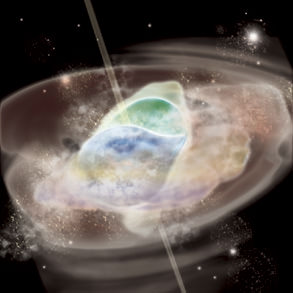
An artist’s impression of merging neutron stars, one of the theoretical progenitors of gamma-ray bursts. Image credit: NASA E/PO, Sonoma State University, Aurore Simonnet. Click to enlarge.
Gamma Ray bursters (GRBs) are almost a daily occurrence – so you’d think follow-up on such things would be routine by now – but that’s just not the case. Imagine a fire department having to respond to a new fire every day: they’d still have to pull on hats and heavy raincoats, slide down shiny metallic poles, and jump onto their fire engine as fast as possible.
And on Monday, May 9th, 2005 there were two fires; one reported earlier in the day by NASA’s HETE-2, and then another by its even more sophisticated associate SWIFT.
So even as we were working on a previous story for Universe Today readers about a dark Gamma Ray Burster detected by HETE-2 in August 2002, two new bursts occurred overhead. Both events sounded the alarm and astronomers worldwide scrambled to capture the rapidly diminishing optical afterglow (OAs) that might help explain one of the deepest mysteries in the Universe: how can so much energy be packed into those tiny, massless photons?
GRB events themselves are of two types. Some are “hard and fast” while others are “soft and slow”. When a “hard-fast” event occurs, astronomical fire fighters have to work quickly.
It all begins when HETE-2 or SWIFT detects an outburst from their lonely perches in low Earth orbit. Once a burst is detected, instruments aboard the craft swing around to make a determination of just where in space that event has occurred and capture whatever lingering x-ray data may still be available. Here SWIFT has the advantage over HETE-2 due to its smaller “error circle” – the satellite’s best guess as to the location of the event in the heavens. Data related to location, burst strength, and duration is then beamed to NASA instrument teams on Earth where the data is integrated and advisories are published to enlist available astronomers and instruments.
All this is comparable to an “all points bulletin” going out so astronomers anywhere can scramble to capture what is now the rapidly diminishing afterglow of the main event. Typically only small instruments associated with major observatories respond first, since larger instruments are scheduled months in advance for other projects. You’ll never see the mighty Hubble Space Telescope swing around for one of these events.
Even as available scopes turn to the sky, astronomers look for detailed survey charts of the region associated with the error circle. Why? Because images and data may already be available to simplify afterglow identification along with baseline spectra, and recessionary distances of host galaxies to assist their analysis.
As time passes, larger and larger instruments are made available for use. This is essential since dark GRBs fade quickly and more and more optical depth is needed to pick up the trail. In the case of GRB020819 detected by HETE-2 in 2002 not even the 10-meter Keck ESI instrument (capturing 26th magnitude light) was able to image an afterglow even though it swung around within 15 days of the initial high energy burst. But with SWIFT’s rapid response and tighter error circles its now becoming possible to catch a dark GRB in the act of disappearing for good.
Of the two GRB events of the day, GRB050509B is most promising because its optical light afterglow is relatively dim (fainter than the 20th magnitude) and galaxy is relatively bright (the 15th). And it is because roughly 1 in 10 GRBs are optically impoverished that makes them specially interesting to astrophysicists. Basically current models used to explain dark GRB events predict that a broad range of photon-energy levels should be seen to accompany any gamma-ray outburst. The fact that some GRBs don’t happen to map well against theory is troublesome, and therein lies the itch behind GRB020819’s (and now GRB050509B’s) scratch.
One theory of GRBs is that gamma rays somehow “muscle their way” through intervening matter in space while optical light – the “afterglow” of such an event – does not. This optical extinction scenario has yet to be demonstrated and several dark GRBs show no sign of the kind of massive clouds of intervening matter needed to support it.
Meanwhile there are three theories of the fireball-shock type postulated by astrophysicists to account for all rapidly diminishing short-time scale GRBs. The fireball scenario typically involves an explosion that hurls extremely hot gases at exceedingly high speeds into space after some kind of a cataclysmic event. These gases then interact with other material already present in the interstellar medium (ISM) or material previously ejected into space by the same object at lower velocities. One theory postulates a “relativistic jet” of hot gases penetrating either a stratified “onion” of other slower moving gases or a simple homogeneously filled-“bubble” of gases. The others assume either a rapidly expanding sphere of hot gases into the same type “bubble” or “onion”.
According to an international team of astronomers, data analyzed across the EM spectrum from GRB020819 supports the expanding sphere into homogeneous medium fireball-shock model. Those findings have been documented in a paper entitled “The Radio Afterglow and Host Galaxy of the Dark GRB020819” published May 2, 2005. The related Universe Today article is an online companion to this article entitled “Shedding Light on Dark Gamma Ray Bursters“.
Meanwhile – at this very moment – astronomical “firefighters and fire marshals” are gathering data associated with SWIFT’s detection of GRB 050509B. This process may continue in one form or another for as long as six months. Several years hence a team of investigators – such as that associated with GRB020819 – may attempt to make sense of how a little understood paroxysm of matter and energy occuring some 2.5 billion years ago in the direction of the springtime constellation Coma Berenices could ever have happened in the first place.
To make all this possible numerous and ever larger “eyes on the skies” will have to collect and focus radio, near-infrared, optical, and near-ultraviolet light. All of that information will be sifted through with infinite patience in an effort to forensically determine not “who done it” but “what”.
Written by Jeff Barbour
